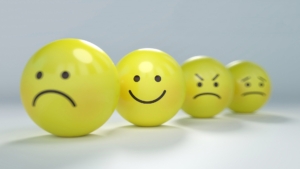Some people seem to drift through life with an even-keeled temper and an ability to meet every challenge with logic and calmness. Others have an emotional reaction to almost every event. In the space of one morning, they might go from brooding frustration to giddy joy and then burst into tears upon seeing a video of a kitten on the internet. Neither person is right or wrong, but the latter person might experience emotional exhaustion, also called emotional dysregulation.
What is emotional dysregulation?
When someone is emotionally regulated, they can experience a broad spectrum of emotions without dwelling on any one of them for too long. Emotions are like clouds in the sky for the emotionally regulated person. Just like the weather, they might experience storms of emotions occasionally, but they return to a more neutral state and continue fulfilling their responsibilities without being affected for too long.
Emotional dysregulation, on the other hand, is when a person’s emotions are heightened, and they feel out of control of their reactions or responses. The smallest things trigger an emotional response, and these responses might feel disproportionate or extreme.
 A simple text message, an expression on a coworker’s face, a perceived cold shoulder from a loved one, or a beautiful piece of music are all things that might have a profound effect on the emotionally dysregulated person. Additionally, they may struggle to sleep at night, be unable to focus during the day, or turn to unhealthy habits as a way of coping, like substance use or binge eating.
A simple text message, an expression on a coworker’s face, a perceived cold shoulder from a loved one, or a beautiful piece of music are all things that might have a profound effect on the emotionally dysregulated person. Additionally, they may struggle to sleep at night, be unable to focus during the day, or turn to unhealthy habits as a way of coping, like substance use or binge eating.
If this sounds like an exhausting experience, know that it is. Most of the time, the person experiencing emotional exhaustion is only aware that they are not okay but have no clue as to why they are in that state, or how to stabilize themselves. Emotional dysregulation is a state often present in highly sensitive people, those with ADHD, or those coping with complex post-traumatic stress disorder (CPTSD), but it affects those who are outside of those parameters, too.
Emotionally dysregulated people might feel ashamed for their inability to control their emotions, a feeling often reinforced by those around them who act dismissive or impatient.
What does emotional dysregulation look like?
Besides the aforementioned examples, emotional dysregulation looks:
- Sensitivity to criticism.
- Extreme self-consciousness.
- Perfectionism – wanting everything to be a certain way.
- Hypervigilance – being on the lookout for the slightest mood shift in people you trust.
- Emotional outbursts – anger, joy, disgust, affection.
- Being more confrontational or combative than usual.
- Withdrawing and cutting ties.
- Binge-purge behavior – deleting all social media on a whim or doom-scrolling for hours.
- Suicidal thoughts or self-harm.
- Fluctuations of romantic feelings.
- Extreme physical sensations, such as feeling repulsed by the feeling of jewelry or hair on your face, or the feeling that your clothes are overwhelming you.
- Feeling overwhelmed in brightly lit or busy, noisy spaces.
- Disrupted routines and unpredictable sleep patterns.
 Ways to regulate your emotions
Ways to regulate your emotions
Emotional exhaustion is tricky because, unlike physical tiredness, you can’t cancel it out with a good nap (although developing a good sleep routine will help). It is usually a process of developing habits that help the emotionally dysregulated nervous system calm itself and return to a balanced state. Ways to help regulate your emotions are:
Try to name your emotions the moment you feel them
It’s not uncommon or shameful to be unaware of your feelings. Sometimes emotions clump together like spaghetti, and it’s necessary to untangle them to identify what they are. When you can identify which emotions you are feeling, you will understand your triggers better and learn what to do in the future; whether that means you avoid certain situations or learn to express yourself more clearly.
If you are struggling to identify your emotions, one helpful practice is to focus on your body’s sensations. For example, you might know that you feel angry, but perhaps your hands are sweating, and your body feels hot. You might feel confused and your stomach hurts. These are important details and simply taking a few moments to focus on them means that you are gaining some understanding of yourself, and not focusing on the triggering situation.
Express yourself in writing
People who are emotionally dysregulated tend to act impulsively, which often comes with unwanted consequences. You can interrupt this instinct by taking the time to express what you are feeling in words.
Not everyone expresses themselves fluently in writing, but the physical act of typing or writing your thoughts and feelings out helps you to slow down and evaluate things. You can always return to what you have written to add context or understanding you might have gained later.
Express yourself verbally
 The reason talk therapy is effective is because it gives us insight about ourselves. You might not have another person on hand to reflect with, but you could record a voice note or video of yourself talking about a triggering situation or describing your emotions.
The reason talk therapy is effective is because it gives us insight about ourselves. You might not have another person on hand to reflect with, but you could record a voice note or video of yourself talking about a triggering situation or describing your emotions.
Take note of how your emotions affect your communication, and what you are saying. Some emotions simply need to be vented, and this is one way that you can let them out safely, whether you share the recording with anyone else or not.
Express yourself physically
This one is for the times when you are alone or in a space where you will not be judged. Some emotions can’t be expressed in any dignified or socially acceptable way but letting them out is still healthier than bottling them up.
Physical movement is an incredibly effective way of doing this. It could be singing along loudly to a song that matches your mood, dancing in an uninhibited way, or hiking to a place where you can safely express yourself in whatever way feels appropriate. Physical activity releases hormones like endorphins and dopamine that counter stress, tension, and nerves, and that could be exactly what your body needs.
Separate yourself from the stimulus
Sometimes you simply do not need to stay in an environment that is overwhelming for you. This might even be a place that is neutral or even beneficial to others.
A loud, early morning worship service in a church might do nothing for a frazzled nervous system, and God would understand if you needed to step out and find a quiet spot where you could be more contemplative in your worship. Getting some distance from your emotional triggers is a survival tip for some, and you are not weak or strange for needing peace at certain moments.
Things you might need to hear about ways to regulate your emotions
 We can teach ourselves to use a strong internal emotion as a cue to take a moment to think before we respond. Being more sensitive to the way things are said or how we are treated, in and of itself, is not problematic. Rather, it is how we choose to respond as a result of that strong emotion that can have undesired outcomes.
We can teach ourselves to use a strong internal emotion as a cue to take a moment to think before we respond. Being more sensitive to the way things are said or how we are treated, in and of itself, is not problematic. Rather, it is how we choose to respond as a result of that strong emotion that can have undesired outcomes.
Regardless of whatever is causing your emotional dysregulation, you are not abnormal, you are not “too much,” and you are not “too sensitive.” It is exhausting and sometimes scary to feel out of control of your emotions, and there is not always an easy fix or a quick solution to regulate yourself. However, it is possible over time to make a difference in how you respond to distressing situations.
There is a way to become emotionally regulated, but it might require some new habits, some more discipline, and some understanding of yourself. You are fearfully and wonderfully made as an individual, and if it seems like no one can see that, there is always the One who does. You will be okay – it is not too late.
Help for more ways to regulate your emotions
If you would like to learn more about emotional regulation or find someone to walk with you on your journey to emotional wellness, we can help. We have access to several professional counselors who each provide a non-judgmental, warm environment for their clients. Contact us when you are ready, and we will connect you with someone who can help.
“Emoticons”, Courtesy of AbsolutVision, Pixabay.com, CC0 License; “Frustrated”, Courtesy of daveingreece, Pixabay.com, CC0 License; “Overcast”, Courtesy of Zozz_, Pixabay.com, CC0 License; “Girl Amid the Flowers”, Courtesy of NGuyễn_Quang_Thắng, Pixabay.com, CC0 License











